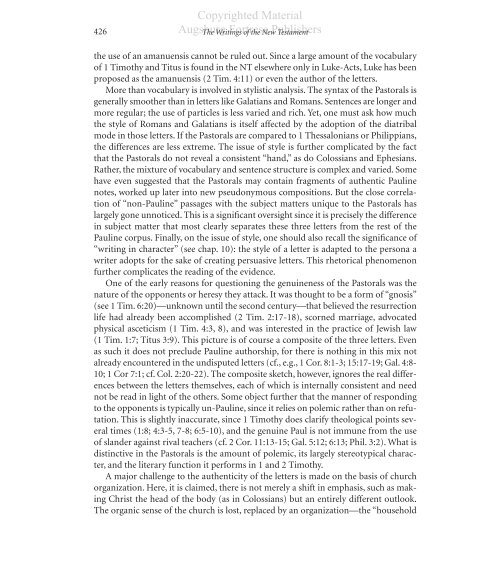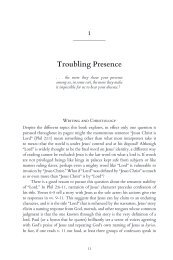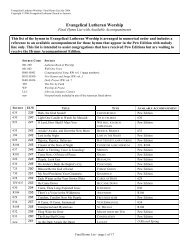19. Pastoral Letters: 1 Timothy, 2 Timothy, Titus - Augsburg Fortress
19. Pastoral Letters: 1 Timothy, 2 Timothy, Titus - Augsburg Fortress
19. Pastoral Letters: 1 Timothy, 2 Timothy, Titus - Augsburg Fortress
You also want an ePaper? Increase the reach of your titles
YUMPU automatically turns print PDFs into web optimized ePapers that Google loves.
426<br />
Copyrighted Material<br />
<strong>Augsburg</strong> <strong>Fortress</strong> Publishers<br />
The Writings of the New Testament<br />
the use of an amanuensis cannot be ruled out. Since a large amount of the vocabulary<br />
of 1 <strong>Timothy</strong> and <strong>Titus</strong> is found in the NT elsewhere only in Luke-Acts, Luke has been<br />
proposed as the amanuensis (2 Tim. 4:11) or even the author of the letters.<br />
More than vocabulary is involved in stylistic analysis. The syntax of the <strong>Pastoral</strong>s is<br />
generally smoother than in letters like Galatians and Romans. Sentences are longer and<br />
more regular; the use of particles is less varied and rich. Yet, one must ask how much<br />
the style of Romans and Galatians is itself affected by the adoption of the diatribal<br />
mode in those letters. If the <strong>Pastoral</strong>s are compared to 1 Thessalonians or Philippians,<br />
the differences are less extreme. The issue of style is further complicated by the fact<br />
that the <strong>Pastoral</strong>s do not reveal a consistent “hand,” as do Colossians and Ephesians.<br />
Rather, the mixture of vocabulary and sentence structure is complex and varied. Some<br />
have even suggested that the <strong>Pastoral</strong>s may contain fragments of authentic Pauline<br />
notes, worked up later into new pseudonymous compositions. But the close correlation<br />
of “non-Pauline” passages with the subject matters unique to the <strong>Pastoral</strong>s has<br />
largely gone unnoticed. This is a significant oversight since it is precisely the difference<br />
in subject matter that most clearly separates these three letters from the rest of the<br />
Pauline corpus. Finally, on the issue of style, one should also recall the significance of<br />
“writing in character” (see chap. 10): the style of a letter is adapted to the persona a<br />
writer adopts for the sake of creating persuasive letters. This rhetorical phenomenon<br />
further complicates the reading of the evidence.<br />
One of the early reasons for questioning the genuineness of the <strong>Pastoral</strong>s was the<br />
nature of the opponents or heresy they attack. It was thought to be a form of “gnosis”<br />
(see 1 Tim. 6:20)—unknown until the second century—that believed the resurrection<br />
life had already been accomplished (2 Tim. 2:17-18), scorned marriage, advocated<br />
physical asceticism (1 Tim. 4:3, 8), and was interested in the practice of Jewish law<br />
(1 Tim. 1:7; <strong>Titus</strong> 3:9). This picture is of course a composite of the three letters. Even<br />
as such it does not preclude Pauline authorship, for there is nothing in this mix not<br />
already encountered in the undisputed letters (cf., e.g., 1 Cor. 8:1-3; 15:17-19; Gal. 4:8-<br />
10; 1 Cor 7:1; cf. Col. 2:20-22). The composite sketch, however, ignores the real differences<br />
between the letters themselves, each of which is internally consistent and need<br />
not be read in light of the others. Some object further that the manner of responding<br />
to the opponents is typically un-Pauline, since it relies on polemic rather than on refutation.<br />
This is slightly inaccurate, since 1 <strong>Timothy</strong> does clarify theological points several<br />
times (1:8; 4:3-5, 7-8; 6:5-10), and the genuine Paul is not immune from the use<br />
of slander against rival teachers (cf. 2 Cor. 11:13-15; Gal. 5:12; 6:13; Phil. 3:2). What is<br />
distinctive in the <strong>Pastoral</strong>s is the amount of polemic, its largely stereotypical character,<br />
and the literary function it performs in 1 and 2 <strong>Timothy</strong>.<br />
A major challenge to the authenticity of the letters is made on the basis of church<br />
organization. Here, it is claimed, there is not merely a shift in emphasis, such as making<br />
Christ the head of the body (as in Colossians) but an entirely different outlook.<br />
The organic sense of the church is lost, replaced by an organization—the “household




